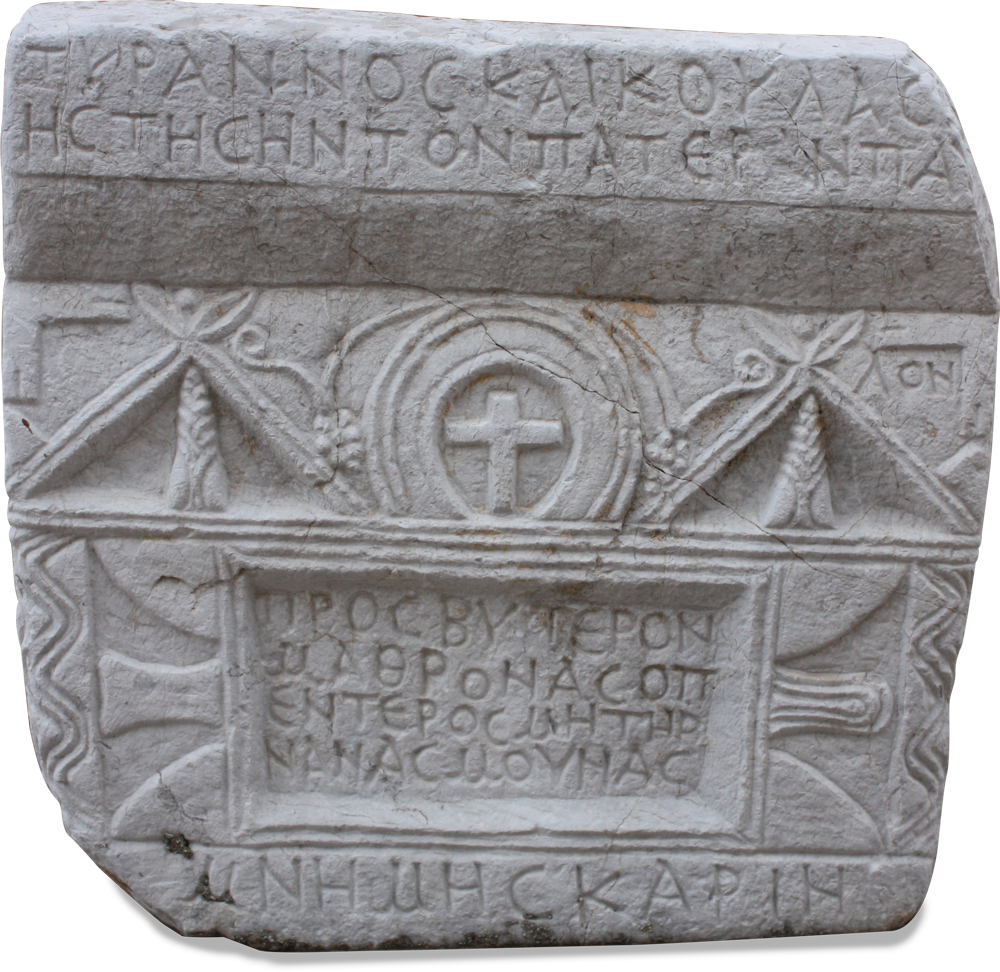The database is intended solely for scientific, non-commercial, and research purposes and adheres strictly to the German copyrights legislation.
Please abide by the ‘License’ and ‘Conditions of Use’ for using or reproducing photographic material.
About ICG
Inscriptiones Christianae Graecae (ICG) is a digital collection of early Greek Christian inscriptions from Asia Minor and Greece dating from ca. II–VI CE. In continuation of a repository published in edition|topoi, the primary objective of the ICG database is to collect systematically and organise regionally all the known early Greek Christian inscriptions from Asia Minor and Greece dating approximately between the second and the fifth or sixth centuries AD. This digital collection does not constitute a digital epigraphic corpus per se, nor is it intended to replace printed critical editions of the original texts. Rather, it is a repertory whose primary purpose is to record early Greek Christian epigraphic documents, and to assist researchers with the analysis and interpretation of material to write historical accounts on the rise and expansion of Early Christianity in Asia Minor and Greece in the series ECAM and ECG.
The database contains so far more than 4,300 inscriptions and 6,200 images from central Anatolia (Lycaonia, Phrygia, Galatia) and from mainland Greece (Attica, Corinthia, Central Greece, Macedonia, and the Peloponnese), the northern Balkans (e.g. Thracia), and some Aegean islands. Inscriptions from the northern, western, and southern coastal regions of Asia Minor (e.g., Asia, Caria, Ionia, Bithynia, Pontus, Pamphylia and Pisidia, and Cilicia) and the remaining Agean islands, will also be processed and included in the database in the coming few years.
Each ICG entry features the original Greek text, a German or English translation, a concise critical apparatus and commentary, images (whenever available), as well as all the relevant information pertaining to dating, ancient and modern provenances, current location, and circumstances of discovery (whenever such information is known). Scans of squeezes of inscriptions found in Greece are used by courtesy of IG (BBAW). The database allows simple searches of single terms, be they letter combinations or words, in the original (normalized) Greek (and sometimes Latin) texts and in the German or English translations and commentaries.
The database also allows for more complex searches by combining various filters (‘Dating’, ‘Region’, etc.). For more information, please read the detailed instructions under the search tool bar on the inscription list page by clicking on the question mark sign (?).
(Please note that the same inscription may be included in several sub-folders. For example, an inscription approximately dated between 200-500 will be included in three folders: 3. century, 4. century, and 5. century.)
(Also note, not all available inscriptions and illustrations can be seen in open access. Researchers can request more comprehensive access from the project leaders.)
People
Project leaders:
Cilliers Breytenbach (Berlin)
Christiane Zimmermann (Kiel)
Advisory board:
Klaus Hallof (IG)
Stephen Mitchell † (BIAA)
Ulrich Huttner (Siegen)
Editors:
Julien Ogereau (2025-)
Former editors:
Ulrich Huttner (2008-2014)
Julien Ogereau (2014-2017)
Marina Veksina (2014-2018)
Maya Prodanova (2017-2019)
Patrick Hommel (2020-2022)
Timo Christian (2023-2025)
Technical development:
Sebastian Kruse (2008-2018)
Markus Konradt (2008-2018)
Daniel Werning (2018)
Nils Berns (2021-2022)
Contact:
cilliers.breytenbach@hu-berlin.de
c.zimmermann@email.uni-kiel.de

Christian Inscriptions
An inscription is considered as Christian if it (1) was set up by or for someone who identifies him/herself as Christian (e.g., χρι/ηστιανός); (2) and/or presents easily recognisable Christian symbols (e.g., Greek/Latin crosses, Christograms, staurograms, nomina sacra, or signa such as ΙΧΘΥΣ or ΧΜΓ); (3) and/or contains specific Christian titles, offices or epithets (e.g., ἐπίσκοπος, πρεσβύτερος, διάκονος/διακόνισσα, δοῦλος/δούλη τοῦ Θεοῦ/Χριστοῦ), biblical citations or allusions, as well as words (e.g., κοιμητήριον, ἀνάστασις), formulae or acclamations (e.g., μνήμης +άριν for μ. χάριν, ζήσῃς ἐν θεῷ), maledictory formulae (e.g., πρὸς τὸν θεόν/ Ἰησοῦν Χριστόν, δώσει λόγον τῷ θεῷ) that are typically used by Christians; (4) features names that are frequently (though not solely) attributed to Christians (e.g., Παῦλος, Κυριακός, Θέκλα, Κεφᾶς, Πέτρος, Ἀναστασία/ιος); (5) was set up in a Christian building (e.g., votives, acclamations, or building dedications).
While some of the above-mentioned clues may not always represent conclusive evidence when found on their own, a combination of several of these increases the likelihood that the inscription is indeed Christian.
The editors intentionally adopted a more inclusive (rather than exclusive) approach in selecting and collecting the material. The database thus includes a number of documents that cannot be identified with certainty as Christian, or that were once thought to be Christian by earlier editors but which may no longer be so considered—in such cases, a concise discussion is generally included in the ‘Comments’ section, leaving the final decision to the user.
Citation
C. Breytenbach and C. Zimmermann (eds.),
Inscriptiones Christianae Graecae (ICG): A database of early Christian inscriptions.
Online at https://icg.uni-kiel.de
Inscriptions in the database should be referenced as, e.g. ICG 811
© Cilliers Breytenbach and Christiane Zimmermann
Links
Below is a succinct list of other helpful epigraphic databases or collections.
The Packard Humanities Institute
Charlotte Roueché, Aphrodisias in Late Antiquity (2nd ed.; 2004)
Peter Thonemann and Charles Crowther, Monumenta Asiae Minoris Antiqua XI (2012)
Die Epigraphische Datenbank Heidelberg
Epigraphic Database Bari (EDB)
Epigraphic Database Rome (EDR)